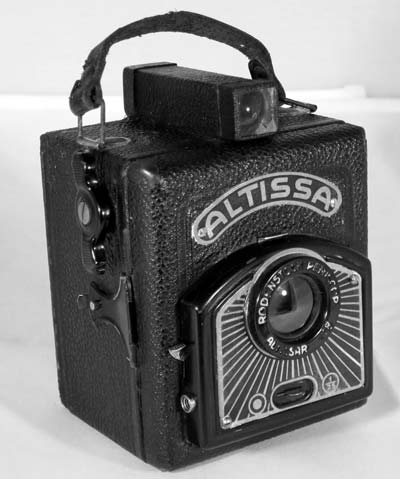Altissa Box 200
Specification

| Manufacturer | : | Eho-Altissa |
|---|---|---|
| Produced | : | 1936 |
| Classification | : | Medium Format |
| Body Type | : | Box |
| Construction | : | Metal |
| Film Type | : | 120 |
| Film width | : | 62mm |
| Image Size | : | 2¼ x 2¼ |
| No. of Images | : | 12 |
| Lens Type | : | Rodenstock Periskop |
| Focal Length | : | 62mm |
| Focus Type | : | fixed |
| Focal Range | : | 5ft - Inf. |
| Aperture Type | : | Multihole |
| Apertures | : | f/8, f/16 |
| Shutter Type | : | Fixed Speed |
| Shutter Speeds | : | B, I(1/25s)nominal, *1/100s |
| Size (w x h x d) | : | 82 x 100 x 75 mm |
| Weight | : | 280g |
| * Measured on this camera | ||
Art Deco Credentials
![]()
![]()
![]()
Noteworthy: Worth giving special attention
- Produced during the main Art Deco period.
- Sunburst decoration around lens
- Art Deco font on name plate
- Chrome red window bezel
- Square housing to viewfinder
- Decorative embossed lines in body leatherette
Description
The Altissa Box 200 was the first of a line of Altissa box cameras having the recognisable sunburst pattern on the front plate. The list includes the 1938 Altissa Juwel and the Altissa Box D.
The camera itself is very striking with a square long box for the viewfinder. It was one of the first cameras to have this type of viewfinder.
The lens is of the periscopic type and has two meniscus lenses in a symmetrical position on both sides of the shutter and aperture. A sliding tab allows the selection of an aperture of f/8 or f/11. The red window has a metal blind that can be drawn over it. It has a tripod socket in the base.
How to Use
This camera takes 120 film which is widely available.
The aperture choice is f/8 or f/16. The speed quoted on the front of the camera is 1/25s but the measured speed on this camera was 1/100s. As the shutter speed is slow, it is advisable to use a tripod to get clear shake free images. However, holding it against a wall or other solid object would work as well. For quick snapshots, hold it firmly against your body.
The table shows how this camera will perform using ISO 100 film assuming the stated speed of 1/25s. It is based on the 'Sunny 16' rule. Modern film is so forgiving and will produce acceptable results even when overexposed by 2 or 3 stops or underexposed by 1 stop.
The tables assume that the sun is at least 30 degrees above the horizon - that's 10am - 5pm on a summers day in the UK.
Remember that the exposure guide in the manual may not be helpful as it is based on the use of old film with a low ISO value.
Using ISO 100/125 film - shutter speed 1/25s
| Weather Conditions | Shadow Detail | Aperture | Exposure |
|---|---|---|---|
 Sunny SunnySnow/Sand | Dark with sharp edges | f/16 | +3 Stops Overexposed Acceptable |
 Sunny Sunny | Distinct | f/16 | +2 Stops Overexposed Acceptable |
 Slight Overcast Slight Overcast | Soft around edges | f/16 | +1 Stops Overexposed Acceptable |
 Overcast Overcast | Barely visible | f/16 | Good |
 Heavy Overcast Heavy Overcast | None | f/8 | +1 Stops Overexposed Acceptable |
 Open Shade Open Shade/Sunset | None | f/8 | Good |
However, the measured speed of this particular camera was 1/100s. This being the case, the table would have to be adjusted as shown.
It is always better to overexpose rather than underexpose so where you have a choice of apertures, one which gives underexposure and one that give overexposure, it is always best to choose the aperture which gives overexposure. Hence the choice of f/8 over f/16 in some cases on the tables.
Using ISO 100/125 film - shutter speed 1/100s
| Weather Conditions | Shadow Detail | Aperture | Exposure |
|---|---|---|---|
 Sunny SunnySnow/Sand | Dark with sharp edges | f/16 | +1 Stops Overexposed Acceptable |
 Sunny Sunny | Distinct | f/16 | Good |
 Slight Overcast Slight Overcast | Soft around edges | f/8 | +1 Stops Overexposed Acceptable |
 Overcast Overcast | Barely visible | f/8 | Good |
 Heavy Overcast Heavy Overcast | None | f/8 | -1 Stops Underexposed Acceptable |
 Open Shade Open Shade/Sunset | None | f/8 | -2 Stops Underexposed Unacceptable |